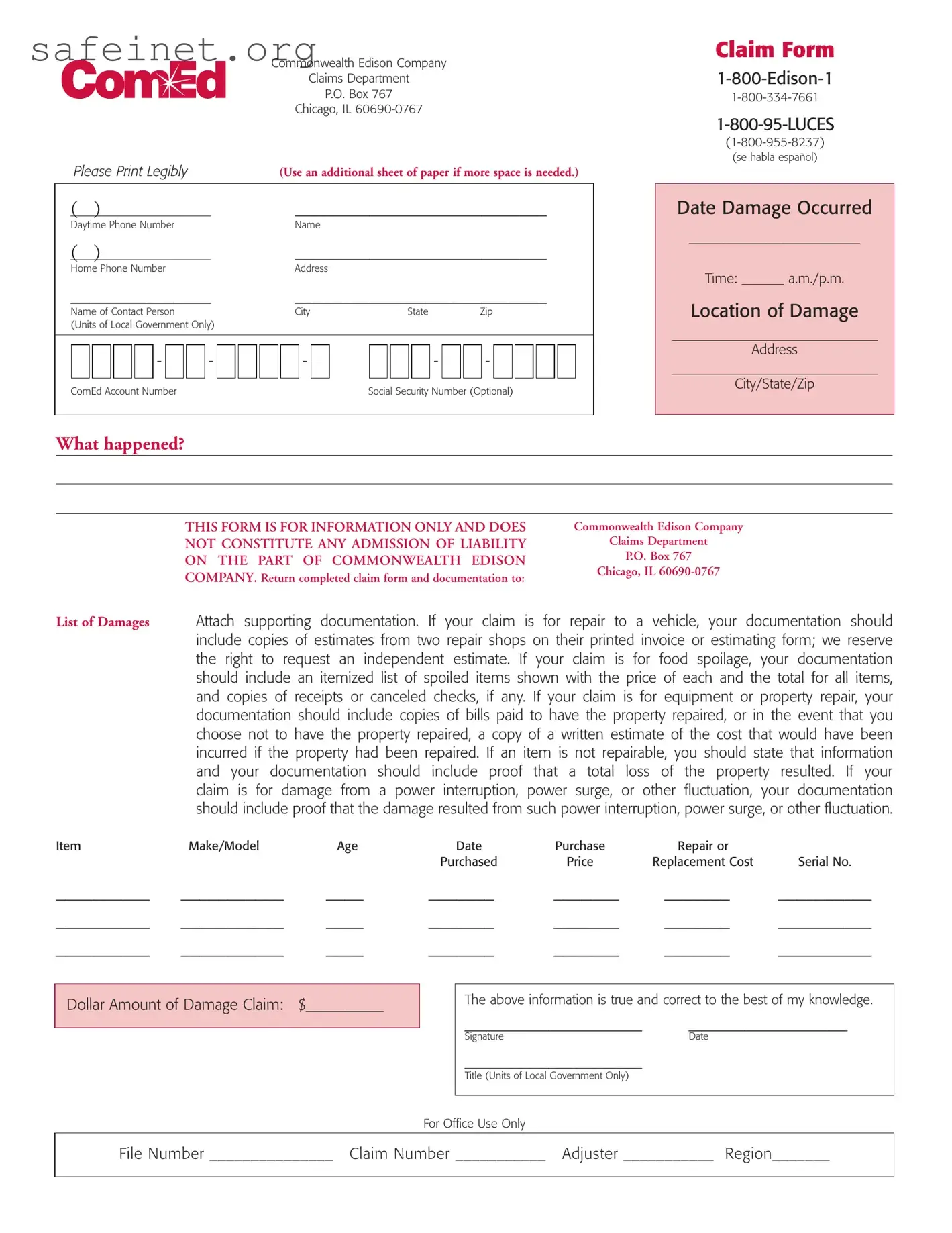The ComEd 1800 form is akin to an insurance claim form. Both documents serve to report damages or losses and request compensation for those incidents. An insurance claim form typically requires the claimant to provide information about the event, identify the parties involved, and present evidence of the damage. Similar to the ComEd 1800 form, these documents often ask for detailed descriptions and supporting documentation, such as photographs or repair estimates, to substantiate the claim. However, while the ComEd form addresses utility-related incidents, insurance forms cover a broader spectrum of potential damages including health, vehicular, and homeowner claims.
Another related document is a warranty claim form. When consumers purchase products, they often receive warranties that promise repair or replacement if certain conditions are met. A warranty claim form allows a consumer to request fulfillment of that promise when a product fails or is damaged. Like the ComEd 1800 form, this document requires specific details about the product, the nature of the damage, and supporting proof of purchase. Both forms aim to protect consumer rights, albeit in different contexts. The ComEd form deals specifically with utility services, while warranty claims can span various types of goods.
A customer service complaint form also parallels the ComEd 1800 form in purposes and processes. Customers use complaint forms to express dissatisfaction with products or services and request resolution or compensation. Much like the claim form, a customer service complaint may require the submission of evidence, such as receipts or records of communication. Both documents reflect the importance of customer feedback in improving services and ensuring accountability. They share common elements such as the need for clarity, specificity, and supporting documentation.
The damage report form for rental properties shares similarities with the ComEd 1800 form as well. Tenants may use it to report damage to property in order to seek repairs or restitution. Both forms require detailed information about the incident, specifics of the damage, and the contact information of the parties involved. Such documentation helps landlords assess liabilities and determine the appropriate action. While the ComEd form is utility-specific, damage reports address a wider range of infrastructure and living conditions.
The vehicle accident report form also demonstrates parallels with the ComEd claim form. Following an auto incident, individuals may fill out a report to document the accident and seek reimbursement for damages. Like the ComEd form, a vehicle accident report requires essential details such as the location, time, and circumstances of the event, as well as estimates for repairs. Both forms prioritize accuracy and evidence. They serve to protect the rights of individuals in potential loss or damage situations, albeit in very different contexts.
The construction defect claim form, often used when building owners discover flaws in workmanship or materials, mirrors the function of the ComEd claim form. Both types of documents require a clear explanation of the issue, evidence of the defect or damage, and ultimately, a request for resolution or compensation. This mirrors how both systems aim to address grievances effectively and responsibly. While the contexts differ—utility services versus construction—the essence of protecting consumers' rights remains the same.
Real estate insurance claims are another variant similar to the ComEd form. Homeowners and property owners submit these claims after suffering damages from covered perils, such as fire or flooding. Like the ComEd claim form, real estate insurance claims require documentation that details the event, the extent of the damage, and relevant receipts or repair estimates. Both forms navigate the complex landscape of claims and compensations while ensuring that proper protocols are followed for assessing losses.
The product recall notification form may also be seen as similar to the ComEd 1800 form. When a company identifies a safety issue with a product, they often use a recall notification form to inform consumers and facilitate the return or replacement of the item. Information such as product details, risks involved, and steps to follow are integral to both forms. While the ComEd form deals with service-related issues, both forms embody the proactive approach of addressing consumer concerns and ensuring safety.
Additionally, a public utility complaint form shares its common purpose with the ComEd claim form. Individuals file these forms when they experience issues with utility services, such as outages or billing disputes. Much like the claim form, a utility complaint form typically requires detailed information along with any supportive documents to facilitate a resolution. Both forms stress the customer's experience with service reliability and quality, aiming to maintain transparency and accountability from companies.
Lastly, a fraud report form for financial institutions can be seen as similar in function to the ComEd claim form. When individuals report suspected fraud, they are often required to document the details of the incident and provide supporting evidence of the alleged fraudulent activities. This echoes the requirements seen in the ComEd form concerning damage verification and the need for clear, detailed reporting. Both forms, albeit serving different sectors, strive to protect consumer interests by promoting accountability and facilitating recovery in cases of loss or harm.


